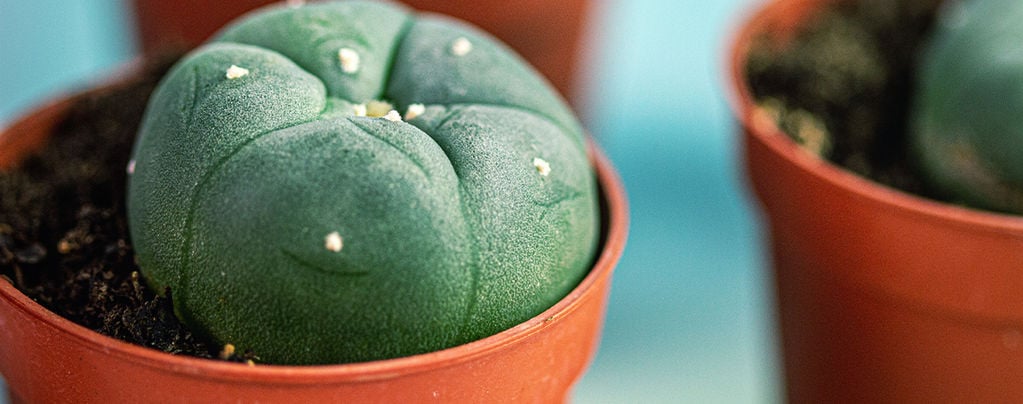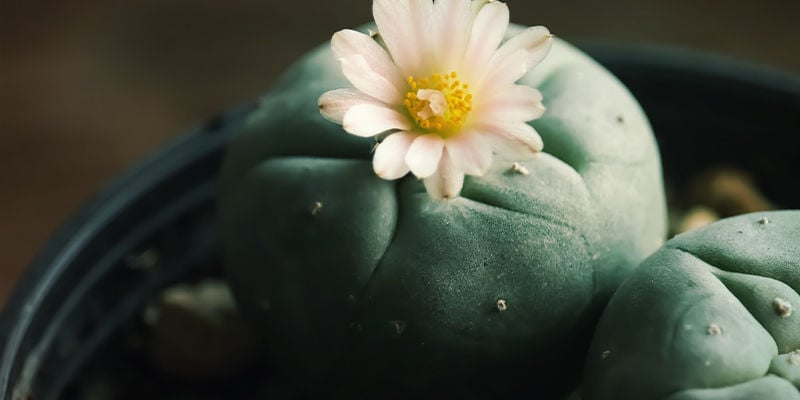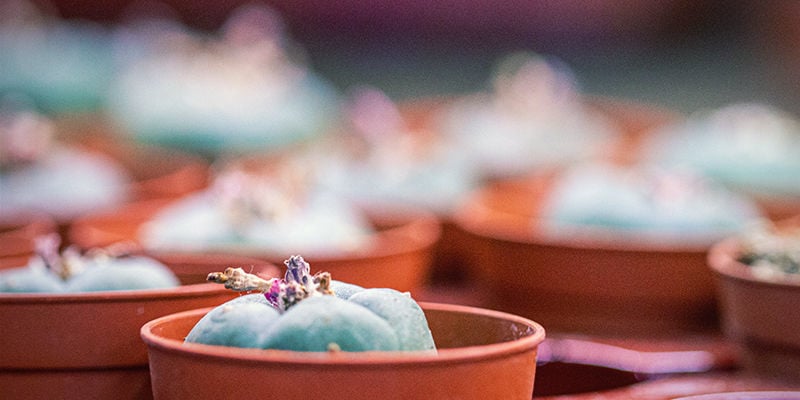
Lophophora Decipiens: A Faster-Growing Peyote
Formerly a subspecies to Lophophora williamsii, Lophophora decipiens is now its own peyote species. Learn more about it and how it differentiates from the "regular" peyote cactus you know and love.
LOPHOPHORA DECIPIENS: A NEW DISTINCT MEMBER TO THE PEYOTE FAMILY
Lophophora williamsii is a plant species of the genus Lophophora, which is part of the cactus family. More commonly referred to as "peyote," this famous cactus contains the entheogen mescaline and is consumed by shaman and modern psychonauts alike to achieve a similar effect to LSD or psilocybin. But this text is about Lophophora decipiens. Until recently, Lophophora decipiens was considered a subspecies of Lophophora williamsii. Now, experts have classified it as its own peyote species; so, the family has a new, independent member. Originating from Torréon and El Amparo in the Mexican state of Coahuila, Lophophora decipiens is very hard to find in its native territories.
But what makes this species so exciting and special? Why wasn't it classified as its own peyote species in the first place? What differentiates Lophophora decipiens from Lophophora williamsii? Relax! We will try to reveal all the answers in this blog.
WHAT ARE LOPHOPHORA?

The whole classification of the Lophophora genus is a bit of a mess. That's why it took so long to classify Lophophora decipiens correctly. Originally, the genus name was used by Leon Croizat to describe plants that displayed well-defined tubercles, but no sharply defined ribs.
Sometimes, the tubercles of these plants are squarish or trapezoidal and defined by deep furrows. The problem here is that this identification applies to several of the recognised species. This classification and naming problem is a really good example of how the variability of the Lophophora genus was assessed falsely. It is a failed attempt to assign this name to a plant which expresses a variant morphology.
In general, the characteristics of the Lophophora genus are plants that grow low, almost geophysically, and form groups of numerous, dense sprouts. These sprouts are of a blue-green, yellowish-green, or sometimes reddish-green colour and are mostly flattened spherical with a recessed sprout top. They reach heights of 2-7cm and have a diameter of 4-12cm. Their often distinct, vertical ribs consist of small and rounded or hunch-like tubercles.
On the top of these tubercles sit areoles. Within them, a fascicle of soft, yellowish, or whitish woolly hair emanates. Between the areoles appear flowers that have a white to pinkish or yellowish-white colour, sometimes even reddish. They open during the day and have a height of 1-2.4cm and a diameter of 1-2.2cm.
THE DIFFERENCES BETWEEN LOPHOPHORA DECIPIENS AND "REGULAR" LOPHOPHORA WILLIAMSII

So, what exactly makes this distinction a big deal? Psychonauts all over the world that grow their own cacti at home could benefit from the slightly different characteristics of decipiens compared to the classic Lophophora williamsii.
In short, you get larger plants sooner. Lophophora decipiens features larger bulbs that are quick to offset. You basically get two rewards if you grow this cactus at home. By doing so, you help to preserve a threatened species and the plant itself provides near-endless insights for the curious psychonaut. The Lophophora decipiens is bigger in every aspect than the traditional peyote cactus. That means the actual body of the cactus is larger and grows faster. The flowers have a white, pink, or magenta colour and are also bigger, with more robust petals. You can easily graft them onto more virile plants like Trichocereus. This way, they grow even faster.
The seeds germinate without any problems and produce many offsets. These offsets erupt with striking seasonal flowers. If you are lucky, you get the one in a thousand that will be pale green and boast white flowers with a delicate pink stripe down each petal. If you want to avoid sterile seeds, you have to cross-pollinate with another Lophophora decipiens.
You saw how Lophophora decipiens has many benefits compared to the traditional peyote cactus. If you want to see for yourself what all the fuss is about, you should definitely head over to our webshop. You will not be disappointed!
-
 4 min
February 5, 2019
9 (Legal) Drugs That Will Induce a Psychedelic Trip
While most psychedelic substances are considered illegal in many countries, there are a few that buck the trend. From plants of the rain forest used for powerful psychedelic brews, to the mystical...
4 min
February 5, 2019
9 (Legal) Drugs That Will Induce a Psychedelic Trip
While most psychedelic substances are considered illegal in many countries, there are a few that buck the trend. From plants of the rain forest used for powerful psychedelic brews, to the mystical...
-
 3 min
August 20, 2017
How Do Hallucinogens, Dissociatives And Delirium-Inducing...
When most people think of trippy drugs, they automatically think of acid and shrooms. But this category of substances is actually very broad and encompasses a variety of different drugs that fall...
3 min
August 20, 2017
How Do Hallucinogens, Dissociatives And Delirium-Inducing...
When most people think of trippy drugs, they automatically think of acid and shrooms. But this category of substances is actually very broad and encompasses a variety of different drugs that fall...
-
 5 min
June 12, 2017
Foods That Can Make You Hallucinate
Food can cause all sorts of feelings and emotions. Despite of making us feel happy when it fills our bellies, there are foods that can excite us or make us tired, cause weird dreams, and even other...
5 min
June 12, 2017
Foods That Can Make You Hallucinate
Food can cause all sorts of feelings and emotions. Despite of making us feel happy when it fills our bellies, there are foods that can excite us or make us tired, cause weird dreams, and even other...
-
 3 min
June 2, 2017
Mescaline Cacti Differences
Mescaline is a psychoactive compound found in several species of cacti. Each species provides its own interpretation of the mescaline experience. How do the effects differ from species to species?...
3 min
June 2, 2017
Mescaline Cacti Differences
Mescaline is a psychoactive compound found in several species of cacti. Each species provides its own interpretation of the mescaline experience. How do the effects differ from species to species?...
-
 2 min
November 15, 2014
The Long-Term Effects of Peyote Use on the Brain
Peyote has been used for entheogenic practices for thousands of years - but what effect does such use have on the brain?
2 min
November 15, 2014
The Long-Term Effects of Peyote Use on the Brain
Peyote has been used for entheogenic practices for thousands of years - but what effect does such use have on the brain?











 United States
United States








